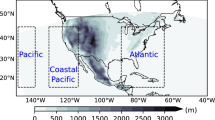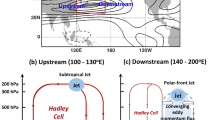Abstract
The major features of the westerly jets in boreal winter, consisting of the Middle East jet stream (MEJS), East Asian jet stream (EAJS) and North Atlantic jet stream (NAJS), simulated by a newly developed climate system model, were evaluated with an emphasis on the meridional location of the westerly jet axis (WJA). The model was found to exhibit fairly good performance in simulating the EAJS and NAJS, whereas the MEJS was much weaker and indistinguishable in the model. Compared with the intensity bias, the southward shift of the WJA seems to be a more remarkable deficiency. From the perspective of Ertel potential vorticity, the profiles along different westerly jet cores in the model were similar with those in the reanalysis but all shifted southward, indicating an equatorward displacement of the dynamic tropopause and associated climatology. Diagnosis of the thermodynamic equation revealed that the model produced an overall stronger heating source and the streamfunction quantifying the convection and overturning Hadley circulation shifted southward significantly in the middle and upper troposphere. The two maximum centers of eddy kinetic energy, corresponding to the EAJS and NAJS, were reproduced, whereas they all shifted southwards with a much reduced intensity. A lack of transient eddy activity will reduce the efficiency of poleward heat transport, which may partially contribute to the meridionally non-uniform cooling in the middle and upper troposphere. As the WJA is closely related to the location of the Hadley cell, tropopause and transient eddy activity, the accurate simulation of westerly jets will greatly improve the atmospheric general circulation and associated climatology in the model.
Similar content being viewed by others
References
Bals-Elsholz, T. M., E. H. Atallah, L. F. Bosart, T. A. Wasula, M. J. Cempa, and A. R. Lupo, 2001: The wintertime Southern Hemisphere split jet: Structure, variability, and evolution. J. Climate, 14, 4191–4215.
Bao, Q., J. Yang, Y. M. Liu, G. X. Wu, and B. Wang, 2010: Roles of anomalous Tibetan Plateau warming on the severe 2008 winter storm in central-southern China. Mon. Wea. Rev., 138, 2375–2384.
Blackmon, M. L., 1976: A climatological spectral study of the 500 mb geopotential height of the Northern Hemisphere. J. Atmos. Sci., 33, 1607–1623.
Bonan, G. B., K. W. Oleson, M. Vertenstein, S. Levis, X. Zeng, Y. Dai, R. E. Dickinson, and Z.-L. Yang, 2002: The land surface climatology of the community land model coupled to the NCAR community climate model. J. Climate, 15, 3123–3149.
Cai, Q. Q., T. J. Zhou, B. Wu, B. Li., and L. X. Zhang, 2011: The East Asian subtropical westerly jet and its interannual variability simulated by a climate system model FGOALS gl. Acta Oceanologica Sinica, 33(4), 38–48. (in Chinese)
Collins, W. D., and Coauthors, 2006: The Community Climate System Model Version 3 (CCSM3). J. Climate, 19, 2122–2143.
Dell’Aquila, A., V. Lucarini, P. M. Ruti, and S. Calmanti, 2005: Hayashi spectra of the Northern Hemisphere mid-latitude atmospheric variability in the NCEPNCAR and ECMWF reanalysis. Climate Dyn., 25, 639–652.
Dickinson, R. E., and Coauthors, 2006: The Community Land Model and its climate statistics as a component of the Community Climate System Model. J. Climate, 19, 2302–2324.
Guo, L. L., Y. C. Zhang, B. Wang, L. J. Li, T. J. Zhou, and Q. Bao, 2008: Simulations of the East Asian subtropical westerly jet by LASG/IAP AGCMs. Adv. Atmos. Sci., 25(3), 447–457, doi: 10.1007/s00376-008-0447-0.
Held, I. M., 1975: Momentum transport by quasigeostrophic eddies. J. Atmos. Sci., 32, 1494–1497.
Held, I. M., and A. Y. Hou, 1980: Zonal jet structure and the leading mode of variability. J. Atmos. Sci., 37, 515–533.
Hoskins, B. J., and K. I. Hodges, 2002: New perspectives on the Northern Hemisphere winter storm tracks. J. Atmos. Sci., 59, 1041–1061.
Hoskins, B. J., M. E. McIntyre, and A. W. Robertson, 1985: On the use and significance of isentropic potential vorticity maps. Quart. J. Roy. Meteor. Soc., 111, 877–946.
Jhun, J.-G., and E.-J. Lee, 2004: A new East Asian winter monsoon index and associated characteristics of the winter monsoon. J. Climate, 17, 711–726.
Kalnay, E., and Coauthors, 1996: The NCEP/NCAR 40-year reanalysis project. Bull. Amer. Meteor. Soc., 77, 437–472.
Koch, P., H. Wernli, and H. C. Daves, 2006: An event-based jetstream climatology and typology. Int. J. Climatol., 26, 283–301.
Krishnamurti, T. N., 1961: The subtropical jet stream of winter. J. Meteor., 18, 172–191.
Kuang, X. Y., and Y. C. Zhang, 2006: Impact of the position abnormalities of East Asian subtropical westerly jet on summer precipitation in middle-lower reaches of Yangtze River. Plateau Meteorology, 25(3), 382–289. (in Chinese)
Lee, S., and H.-K. Kim, 2003: The dynamical relationship between subtropical and eddy-driven jets. J. Atmos. Sci., 60, 1490–1530.
Li, C., and J. J. Wettstein, 2012: Thermally driven and eddy-driven jet variability in reanalysis. J. Climate, 25, 1587–1596, doi: 10.1175/JCLI-D-11-00145.1
Li, C. Y., J. T. Wang, S. Z. Lin, and H. R. Cho, 2004: The relationship between Asian summer monsoon activity and northward jump of the upper westerly jet location. Chinese J. Atmos. Sci., 28(5), 641–658. (in Chinese)
Li, L. J., and Coauthors, 2013a: The flexible global oceanatmosphere-land system model grid-point version FGOALS-g2. Adv. Atmos. Sci., doi: 10.1007/s00376-012-2140-6.
Li, L. J., and Coauthors, 2013b: Evaluation of gridpoint atmospheric model of IAP LASG version 2 (GAMIL2). Adv. Atmos. Sci., doi: 10.1007/s00376-013-2157-5.
Limpasuvan, V., and D. L. Hartmann, 1999: Eddies and the annular modes of climate variability. Geophys. Res. Lett., 26(20), 3133–3136, doi: 10.1029/1999GL010478.
Lin, J.-L., 2007: The double-ITCZ problem in IPCC AR4 coupled GCMs: Ocean-atmosphere feedback analysis. J. Climate, 20, 4497–4525.
Liu, J. P., 2010: Sensitivity of sea ice and ocean simulations to sea ice salinity in a coupled global climate model. Sci. China (Earth), 53 (6), 911–918, doi: 10.1007/s11430-010-0051-x.
Liu, H. L., P. F. Lin, Y. Q. Yu, and X. H. Zhang, 2012: The baseline evaluation of LASG/IAP Climate system Ocean Model (LICOM) version 2. Acta Meteorologica Sinica, 26(3), 318–329, doi: 10.1007/s13351-012-0305-y.
Lu, R. Y., 2004: Associations among the components of the East Asian summer monsoon system in the meridional direction. J. Meteor. Soc. Japan, 82, 155–165.
Morgan, M. C., and J. W. Nielsen-Gammon, 1998: Using tropopause maps to diagnose midlatitude weather systems. Mon. Wea. Rev., 126, 2555–2579.
Ren, X. J., Y. C. Zhang, and Y. Xiang, 2008: Connections between wintertime jet stream variability, oceanic surface heating, and transient eddy activity in the North Pacific. J. Geophys. Res., 113, D21119, doi: 10.1029/2007JD009464.
Ren, X. J., X. Yang, and C. J. Chu, 2010: Seasonal variations of the synoptic-scale transient eddy activity and polar front jet over East Asia. J. Climate, 23, 3222–3233.
Riehl, H., 1962: Jet Streams of the Atmosphere. Tech. Rep. 32, Department of Atmospheric Science, Colorado State University, 177pp.
Sterl, A., 2004: On the (in)homogeneity of reanalysis products. J. Climate, 17, 3866–3873.
Taylor, K. E., R. J. Stouffer, and G. A. Meehl, 2012: An overview of CMIP5 and the experiment design. Bull. Amer. Meteor. Soc., 93, 485–498, doi: 10.1175/BAMS-D-11-00094.1
Trenberth, K. E., and A. Solomon, 1994: The global heat balance: Heat transports in the atmosphere and ocean. Climate Dyn., 10, 107–134.
Wang, X. C., J. P. Liu, Y. Q. Yu, H. L. Liu, and L. J. Li, 2009: Numerical simulation of polar climate with FGOALS-g1.1. Acta Meteorologica Sinica, 67(6), 961–972. (in Chinese)
Woollings, T, A., Hannachi, and B., Hoskins, 2010: Variability of the North Atlantic eddy-driven jet stream. Quart. J. Roy. Meteor. Soc., 136, 856–868. doi: 10.1002/qj.625
Yang, S., K.-M. Lau, and K. M. Kim, 2002: Variation of the East Asian jet stream and Asian-Pacific-American winter climate anomalies. J. Climate, 15, 306–325.
Yang, S., K.-M. Lau, S.-H. Yoo, J. L. Kinter, K. Miyakoda, and C.-H. Ho, 2004: Upstream subtropical signals preceding the Asian summer monsoon circulation. J. Climate, 17, 4213–4229.
Zhang, Y. C., D. Q. Wang, and X. J. Ren, 2008: Seasonal variation of the meridional wind in the temperate jet stream and its relationship to the Asian Monsoon. Acta Meteorologica Sinica, 24(4), 446–454.
Zhou, T. J., and R. C. Yu, 2005, Atmospheric water vapor transport associated with typical anomalous summer rainfall patterns in China. J. Geophys. Res., 110, D08104, doi: 10.1029/2004JD005413
Zhou, T. J., and L. W. Zou, 2010: Understanding the predictability of East Asian summer monsoon from the reproduction of land-sea thermal contrast change in AMIP-type simulation. J. Climate, 23(22), 6009–6026.
Zhou, T. J., Y. Q. Yu, H. L. Liu, W. Li, X. B. You, and G. Q. Zhou, 2007: Progress in the development and application of climate ocean models and ocean-atmosphere coupled models in China. Adv. Atmos. Sci., 24(6), 1109–1120, doi: 10.1007/s00376-007-1109-3.
Author information
Authors and Affiliations
Corresponding author
Rights and permissions
About this article
Cite this article
Xiao, C., Zhang, Y. Simulation of the westerly jet axis in boreal winter by the climate system model FGOALS-g2. Adv. Atmos. Sci. 30, 754–765 (2013). https://doi.org/10.1007/s00376-012-2167-8
Received:
Revised:
Published:
Issue Date:
DOI: https://doi.org/10.1007/s00376-012-2167-8




